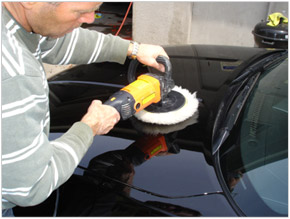 Winter can easily destroy your car with corrosive road salts and dirt collected through slush, ice, and melting snow. Too many times, the damage from corrosive agents goes undetected until the spring thaw. The best favor you can for yourself and for your car is to throw away conventional wisdom, get the garage good and warm, and give your ride a mid-winter wash and wax.
Winter can easily destroy your car with corrosive road salts and dirt collected through slush, ice, and melting snow. Too many times, the damage from corrosive agents goes undetected until the spring thaw. The best favor you can for yourself and for your car is to throw away conventional wisdom, get the garage good and warm, and give your ride a mid-winter wash and wax.
– Have the right supplies. You’ll need plenty of warm water, clean soft towels, and cleaners that are both non-abrasive and non-acidic. You’ll also want conditioners and a high-quality wax.
– Be picky as you examine the car for dirt. Today’s auto designs are more aerodynamic than older models and can shed water through all manner of hidden channels. Be prepared to go over your car in minute detail looking for places where dirt, dead insects, leaves, and other debris can get caught. Be prepared to get under the car and pay particular attention to the wheel wells and bumpers. Use a flash light and don’t forget to just rely on touch. If an area feels gritty, there’s built-up dirt there.
– Don’t forget the baking soda. It’s a good idea to add three tablespoons of baking soda to the wash water you’ll use on all areas of the undercarriage, wheel wells, and bumpers. Baking soda neutralizes the corrosive effects of built up salt without hurting the vehicle’s components.
– Wax carefully and thoroughly. When your car is completely clean and dry, take the time to apply a thorough coat of wax. This will not only give you more time to inspect for damage, but the wax itself is a powerful protection against dirt and salt. Plus, when you’re done buffing, you’ll have a sparkling ride on your hands.
In between washes, get in the habit of rinsing off your wheels, both before and after driving. Using plain water is good, but mixing the water with a non-acidic wheel cleaner is better. The more you can do to keep caustic salt off all the components of your car, the better off you are. (You can wax your wheels too, unless they’re chrome, which needs oxygen to stay shiny and should be left wax-free.) Also, exercise caution when brushing snow off your automobile. Use short, straight strokes, preferably with a soft brush to avoid scratching the surface with any built-up abrasive debris.
Finally, be very careful with your car’s leather seats during cold weather. Scotch Guard is the best solution to protect cloth, but don’t fall into the trap of using solvent-based cleaners and conditioners on leather in cold weather. You’ll only speed up the aging process. Use nothing but solvent-free leather products and make sure the seats are warm before you work with them. Don’t use water at all.
The most important thing, however, is to take steps to inspect and maintain your car during the winter months. Don’t be one of those people who gets their car washed and waxed in the fall and doesn’t touch it again until spring. Chances are good that if you take that route, when you do get all the dirt and grime cleaned off, there’s going to be corrosion damage underneath.





